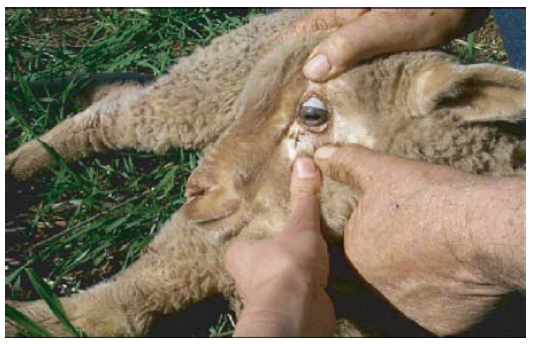Pale lambs that sit when being moved? Could be Mycoplasma ovis
06 Sep 2022
PRODUCTION ADVICE & NRM NEWS - SEPTEMBER 2022 - ANIMAL HEALTH
By Linda Searle, District Veterinarian
P: 03 5881 9919 | M: 0427 629 740 | E: linda.searle@lls.nsw.gov.au
Ever been moving lambs only to have some sit-down, unable to get up? You look at their gums or other, usually pink, bits around their eyes or in their vulva only to find they are as white as a sheet (anaemia) or a very pale yellow (jaundice).
This has been the case for a few properties lately which have been diagnosed with Mycoplasma ovis (previously known as Eperythrozoon ovis, or sometimes Eperythrozoonosis) infection.
The bacteria M. ovis can infect the blood cells of sheep and goats. Infected red blood cells die, leading to anaemia and jaundice.
Infection may be present on a property without being noticed. But if lambs become severely anaemic, they are often found down or dead, especially if they are stressed.
This classically happens when lambs are moved to the yards for weaning, as they suddenly have more oxygen demand, which they can’t meet. However, they may also be found down or dead in the paddock even if they are not moved.
It is usually best to stop the movement if you see lambs struggling to keep up with the mob and collapsing. Seek advice from your vet, you may have to delay the movement until the lambs have sufficiently recovered.
The disease is spread by blood-to-blood contact. This is when infected red blood cells are moved from an infected animal to a susceptible one. This often occurs during marking, mulesing or shearing; however, biting insects can also spread the disease. Wet years, with increased insect activity, can also increase infection rates.
Outbreaks commonly occur 4 to 6 weeks after marking – which often coincides with when the mob is being moved for weaning. In this case, weaning may need to be delayed for 4-6 weeks to give the anaemic lambs enough time to recover.
While it is possible for sheep of any age to be affected, usually older sheep have been infected previously and have developed immunity.
Sheep are generally more likely to show severe signs of M. ovis infection if they have other issues at the same time, such as inadequate nutrition or a large worm burden. In this case, it will be necessary to fix the underlying issues first to solve the problem.
Infection with barber’s pole worm presents very similarly to M. ovis infection, so i. It is important to establish the cause of anaemia. Yarding M. ovis infected lambs to drench can cause deaths, but not drenching sheep with high numbers of barber’s pole worm will conversely cause mortalities.
Infections may occur on the same property in the lambs over successive years. If this is the case on your property, you may consider management procedures to decrease the spread. This could include increased hygiene measures at lamb marking/mulesing or insect control. It is also important to prevent underlying conditions such as parasites and malnutrition.
If you are having trouble with pale lambs or want further information on M. ovis, contact your vet or call Local Land Services on 1300 795 299.
